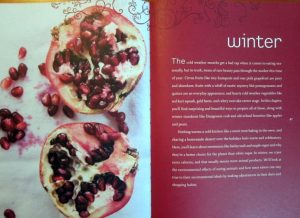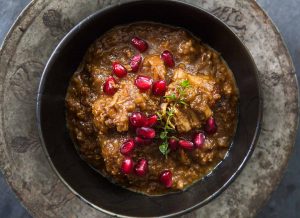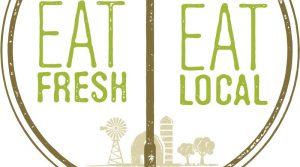What’s Your Cookbook?
Lucid Food is a specialty cookbook based on preserving the earth and reducing waste in the kitchen while also providing nutrition and sustenance in its recipes. The author, Louisa Shafia, emphasizes the appreciation of food and its role in our daily lives. By writing this cookbook, the author hopes to encourage a more widespread appreciation for food and respect for where our food comes from. Shafia also believes that cooking should follow the patterns of the earth’s seasons. This book is comprised of seasonal recipes interspersed with practical information on cooking and sourcing food with an eco-friendly approach.

This book was published in 2010 in the midst of the “Information Age”, also known as the “Computer Age”. This was the time when technology really started to take off and become a necessity in people’s lives. Cell phones, apps and other new technology made it easy for people to take shortcuts. People were beginning to become accustomed to putting in little effort for big rewards. Fast food, premade meals and other cooking and eating shortcuts were becoming more and more popular. People could now order food from their phone and have it show up at their door twenty minutes later. The appreciation for food and cooking on a widespread scale was diminishing. This cookbook was written and published to bring back the appreciation for food, and to help people make great food that will sustain them and the environment.
About the Author
The author of this cookbook is a woman named Louisa Shafia. Shafia works as a chef, caterer, educator, and food writer. She grew up in a family that almost always ate healthy, fresh food while also being “eco-friendly” long before it even occurred to anyone to use that term. Her father grew up in Iran during World War II, so he had a deeper understanding of the appreciation of food because quality food wasn’t always available to him as a child. Her parents also lived through the Great Depression, so they were thrifty, frugal and didn’t let anything go to waste. Her mother also had a garden and enjoyed growing her own fruits and vegetables. Shafia says, “thanks to my upbringing, fresh vegetables are still my comfort food, and I make a point to reuse plastic bags, carry my own thermos and seek out vintage clothes” (Shafia, 2010, pg. 3). Shafia believes that those Depression-era habits were genuinely eco-friendly, and that hard-won knowledge should be taught to a new generation. She has written this cookbook and started her own catering company to try to teach these ideas to more generations. Shafia writes, “I’ve experienced first hand how a cuisine based on the simple virtues of fresh, local foods and ethical consumption can please the most discerning palates while contributing to a better future for our planet” (Shafia, 2010, pg. 3).

Audience
This cookbook has been written so that the average person can read and understand the recipes inside. There is a section in the cookbook after the introduction that is called “Eco-Kitchen Basics”. In this section Shafia gives five habits for eco-friendly food shopping, a dozen ways to reduce waste, and eco-foodie words to watch for in the rest of the cookbook. Shafia has spelled out the basic concepts of being being eco-friendly so that anyone can understand this cookbook if they choose to do so. The intended audience of this cookbook are people who are interested in appreciating food and cooking more and want to be more eco-friendly in the process. Their skill level can be basic. This book is not for people who do not care about the earth or the environment.
The recipes in this book are simple and do not contain many ingredients, but the ingredients are foods that might not be widely available. Some of the ingredients require access to a farmers market or specialty grocery stores like Middle Eastern food stores. Not all people have access to these kinds of markets/stores. An example of a recipe in this book that requires special ingredients is the recipe for Fesenjan (Chicken in Pomegranate Walnut Sauce) on page 91. This recipe requires access to a natural or Middle Eastern food store in order to get the pomegranate syrup that is necessary for the recipe. Other ingredients in the book that are not very common are polenta, basmati rice, saffron, fennel, parsnips, nori, persimmons, rhubarb, and many more. The recipes in this book require basic cooking knowledge. The audience must know basic kitchen terminology like “sauteing”, “broiling”, “whisking” or “drizzling”. There aren’t many directions in the book that an average person wouldn’t understand or be able to do. The biggest barrier in making these recipes would be finding the ingredients for them and using them before they went bad.

Rhetoric & Identity
The rhetoric of this cookbook lends a lot about the identity of the author and the audience. The book is written is a way that assumes that the people who are reading care quite a lot about preserving the earth and reducing waste. It is obvious that the author of this book identifies as a person who is eco-friendly, but I also think that if a person is taking the time to read this book and use the recipes then they most likely identify as being eco-friendly as well. A lot of effort goes into being eco-friendly when shopping, cooking and eating. A person who does not feel strongly about these things would not go through the trouble of reading this book and following what it says.
Another identity marker that is emphasized in the way this cookbook is written is social class. This cookbook is written so that anyone of any social class can adopt these practices if they wish to do so. A common misconception about eating local, fresh and sustainable food is that it is too expensive or exclusive or elitist. Shafia challenges this idea early in the cookbook. She say that “there are many ways to green your diet affordably, and the benefits are myriad” (Shafia, 2009, pg. 6). Shafia wrote this book so that people belonging to most social classes could use it.
Another identity marker that is emphasized in this cookbook is region/geography. It is made clear that it is best to shop locally, so that means that your geography will play a huge role in what you eat. Different foods will be available locally depending on where you live. People who live in California will have a different variety of local foods available compared to people who live in Ohio.

(Women’s Lifestyle Magazine, 2017)
Other Linkages to Class
Foodways-
Foodways can be defined in many different ways. In summary, foodways are the history, tradition, and practices of production and consumption of food. This cookbook highlights very specific foodways to optimize resources and produce eco-friendly and sustainable food. Some of the foodways used in this book are shopping organic, using all of your food to eliminate waste, soaking beans or grains before cooking to reduce cook time, eating seasonal foods, eating less meat or only buying free-range meat, choosing eco-friendly fish, etc.
Biocultural Framework-
The biocultural framework connects an individual’s environments with their cuisine, diet and nutritional status. This cookbook represents the biocultural framework because it emphasizes how important the environment is in cooking, eating and nutrition. This book was written because the sociocultural environment began to change with advancements in technology and changes in ideology with new generations. Shafia wrote this book to shed light on how important the physical environment is. She wanted to encourage people to take a step back from the fast paced world filled with new technologies and really appreciate what the earth has to offer.
References
Shafia, Louisa, and Jennifer Martiné. Lucid Food: Cooking for an Eco-Conscious Life. Ten Speed Press, 2010.
WLMagazine. “Eat Fresh, Eat Local.” Women’s Lifestyle Magazine, 9 June 2017, womenslifestyle.com/eat-fresh-eat-local-37/.